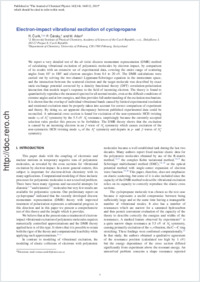Electron-impact vibrational excitation of cyclopropane
- Čurík, Roman J. Heyrovský Institute of Physical Chemistry, Academy of Sciences of the Czech Republic, Prague, Czech Republic
- Čársky, Petr J. Heyrovský Institute of Physical Chemistry, Academy of Sciences of the Czech Republic, Prague, Czech Republic
- Allan, Michael Department of Chemistry, University of Fribourg, Switzerland
-
14.04.2015
Published in:
- The Journal of Chemical Physics. - 2015, vol. 142, no. 14, p. 144312
English
We report a very detailed test of the ab initio discrete momentum representation (DMR) method of calculating vibrational excitation of polyatomic molecules by electron impact, by comparison of its results with an extensive set of experimental data, covering the entire range of scattering angles from 10∘ to 180∘ and electron energies from 0.4 to 20 eV. The DMR calculations were carried out by solving the two-channel Lippmann-Schwinger equation in the momentum space, and the interaction between the scattered electron and the target molecule was described by exact static-exchange potential corrected by a density functional theory (DFT) correlation-polarization interaction that models target’s response to the field of incoming electron. The theory is found to quantitatively reproduce the measured spectra for all normal modes, even at the difficult conditions of extreme angles and at low energies, and thus provides full understanding of the excitation mechanism. It is shown that the overlap of individual vibrational bands caused by limited experimental resolution and rotational excitation must be properly taken into account for correct comparison of experiment and theory. By doing so, an apparent discrepancy between published experimental data could be reconciled. A substantial cross section is found for excitation of the non-symmetric HCH twisting mode ν 4 of A′′1 symmetry by the 5.5 eV A′2 resonance, surprisingly because the currently accepted selection rules predict this process to be forbidden. The DMR theory shows that the excitation is caused by an incoming electron in an f-wave of A′2 symmetry which causes excitation of the non-symmetric HCH twisting mode ν 4 of the A′′1 symmetry and departs in p- and f-waves of A′′2 symmetry.
- Faculty
- Faculté des sciences et de médecine
- Department
- Département de Chimie
- Language
-
- English
- Classification
- Chemistry
- License
-
License undefined
- Identifiers
-
- RERO DOC 255734
- DOI 10.1063/1.4917304
- Persistent URL
- https://folia.unifr.ch/unifr/documents/304333
Statistics
Document views: 91
File downloads:
- pdf: 192
